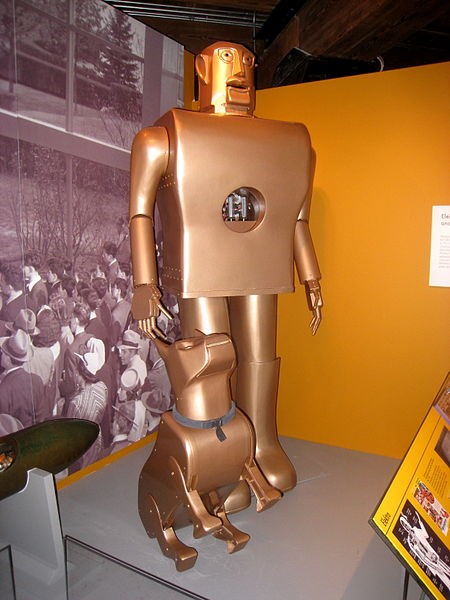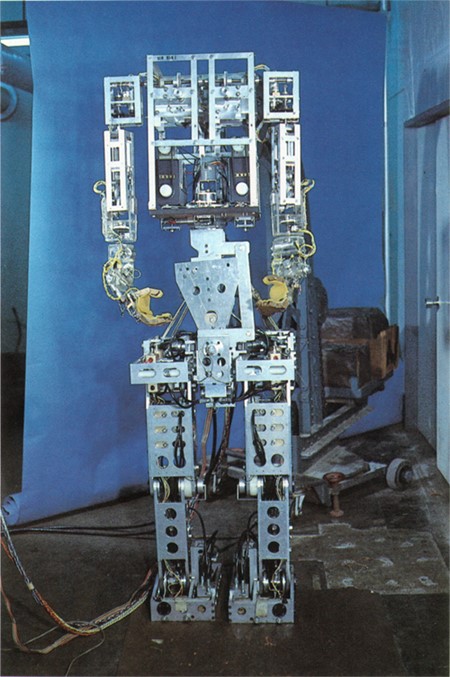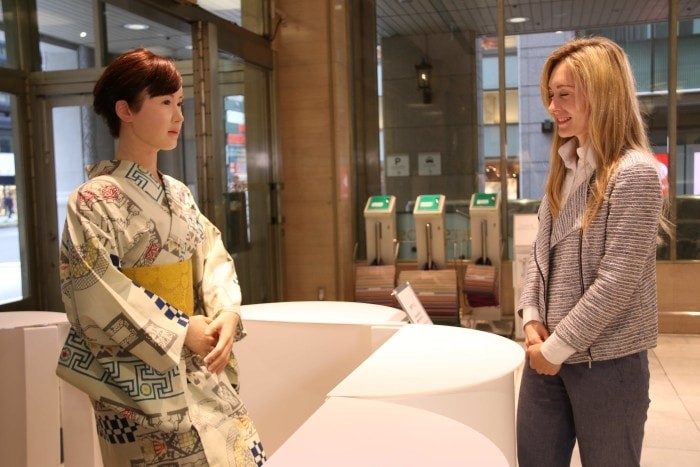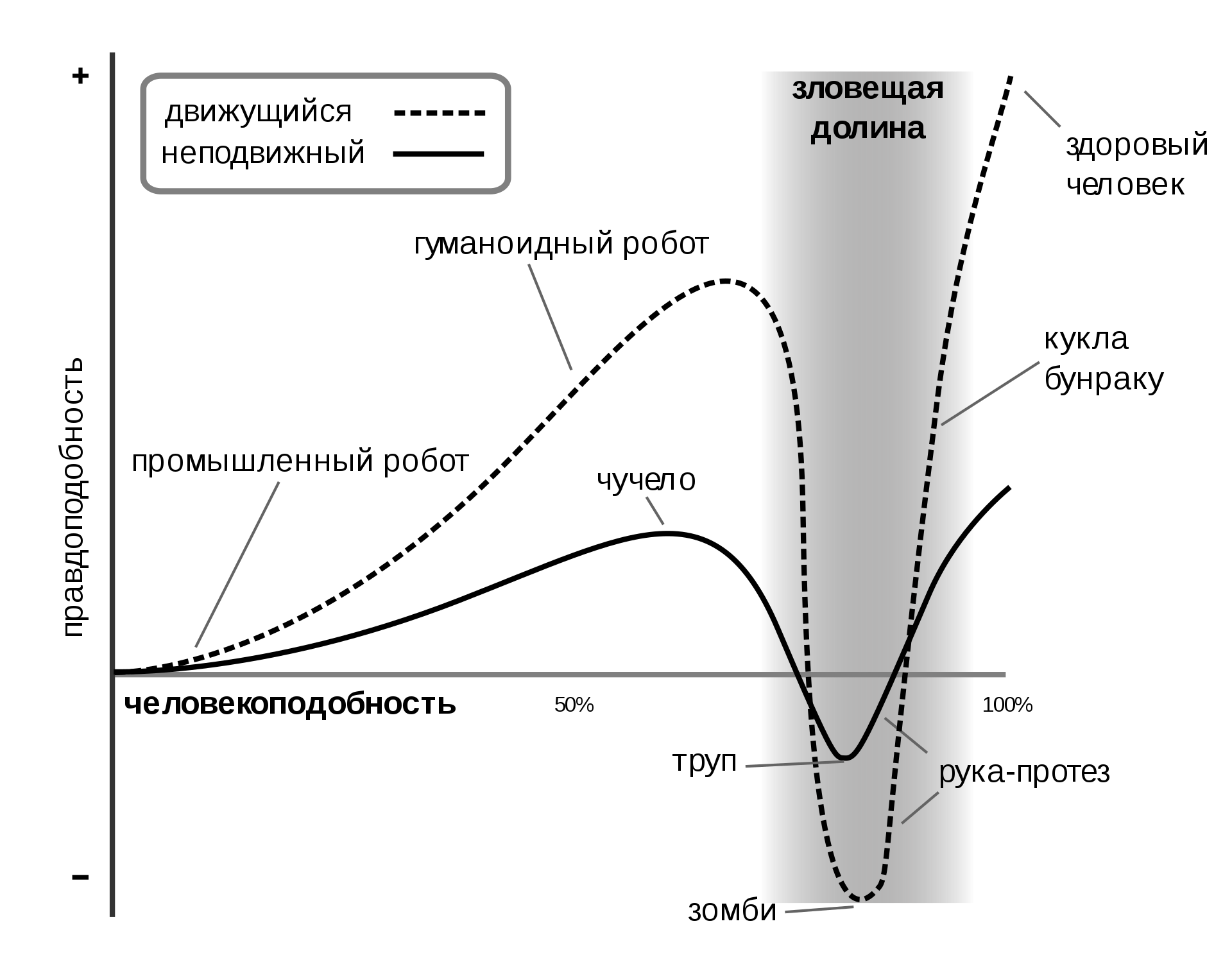Humanoid robots: the benefits and problems of anthropomorphic mechanisms
The idea of making the robot as close to human as possible appeared earlier than the robots themselves - in the play by Karel Čapek RUR (the term was also invented by Čapek) the robots were completely similar to humans. But do we really need humanoid robots? Where are the androids used and why are they so stingy with emotions? We tell in the new article.

Specialized robots in assembling cars, carrying goods and executing other programs cope with their tasks much better than people, but apart from fulfilling their narrow remit, such robots are not suitable for anything else. If we need the most versatile robot, it should feel comfortable in the human environment and infrastructure, which means that it needs to be human-like - after all, the robot vacuum cleaner will not be able to get the cup off the shelf, and the robot welder will not tell how go to the library.
In 1927, seven years after writing the play RUR, the American Westinghouse Electric Company introduced Mr. Herbert Televox - a robot that received signals through a telephone that activated its program. According to the creator, the TV box could turn on the stove or check whether the light in the house was working. In some ways, Televoks was not just a robot, but a component of a “smart” home. The anthropomorphism in Televox was just a useless decoration.
')

One of the Televox with its creator Roy Wensley. Source: Acme Telepictures / NEA
The Elektro robot, which appeared 10 years later in the USA, was a man's height and could perform 26 different actions, including walking. It was controlled by voice, but it didn’t react to words, but to their number — two separate words heard included movement, three meant stopping, any four words that were said returned Elektro to its initial position. A separate motor in the mouth helped the robot to inflate balloons and ... smoke. Since then, humanoid robots mostly retain entertainment orientation.

Elektro robot and his Sparko robopos. Source: Daderot / Wikimedia
Only in 1970, the first humanoid robot capable of carrying loads, WABOT-1, created by Waseda University, was introduced in Japan. He knew how to communicate in Japanese, calculated distances, chose the direction of movement and carried objects in his hands.

WABOT-1 is the first humanoid robot capable of benefiting. Source: Waseda University
90 years have passed since the advent of Mr. Televox. Technology during this time made a tremendous breakthrough, and human-like robots both were and remain an entertainment or information device with a very limited scope.
One of the most famous robots in recent years was Sophia by Hanson Robotics. She can express up to 60 emotions, recognize speech and generate answers based on her own experience and data from the Internet. Sophia is only a demonstration design that benefits as a promotional project - experts admit that while the robot is a regular chat bot with very specific facial expressions, Sophia does not know anything really useful.

Sophia is a very emotional robot, but the transparent cover on the back of your head is a bit scary. Source: International Telecommunication Union
Another robot consultant, Aiko Chihira, created by Toshiba, has a more traditional appearance and a smaller, but more realistic set of facial expressions. Aiko was introduced in 2014 and immediately created a sensation, and six months later, even worked for a couple of days as a consultant in a shopping center in Tokyo. Chikhira moves her eyes, head and hands, 43 motor mechanisms are involved in it, the robot recognizes the voice and responds with replicas in well-set Japanese or English.
Toshiba's Aiko Chihira Robot talks about himself at CEATEC 2014
At Toshiba, Aiko is called a robot for interacting with people (communication robot). Developers expect to use such roboconsultants in the service sector, as well as in medicine to monitor and communicate with patients, but all this will happen in the not very near future. Aiko does not know how to walk and now he can perform only the function of a stationary help desk.

Aiko Chihira at his temporary workplace in a shopping center. Source: Toshiba
There are many other humanoid robots, less well-known, but no less interesting: Actroid-SIT looks into the eyes during a conversation and can touch the other person, and Harmony became the first sex robot capable of supporting a conversation on piquant topics. But with the current level of technology development, all of them are expensive stationary interlocutors and no more. Scientists, on the other hand, dream of rescue robots, digging debris, research robots working with tools in extreme conditions, help robots, and repeating human manual labor.
A universal anthropomorphic robot is a very complex set of musculoskeletal systems, mechanical limbs, voice recognition systems, space and neural networks capable of processing and understanding the environment and voice commands. Separately, some progress has been made in these areas.
So, modern robots can keep up the conversation at the level of voice assistants like Siri, but so far the conversation between the machine and the person is far from the dialogue of two people.
Straight walking on two legs also made a big breakthrough in the last thirty years - it is worth comparing at least the leisurely movements of the Honda E0 and the Atlas jogging. True, to ensure such mobility, Atlas received equipment for 80 kg and a height of about 180 cm. What does this, perhaps, the most impressive robot of our time? For now, just carry five kilo boxes . By the way, take a look at the head of the robot - a lidar rotates there, scanning the surrounding space and making up a three-dimensional map of the world around. This allows the robot to respond as accurately as possible to obstacles, namely to bypass or step over them. We told about the work of lidars in our material about unmanned vehicles .

So SpotMini sees the world with the Velodyne VLP-16 compact lidar. Source: frame from Boston Dynamics video
The biggest difficulty is the brain of the robot. Machines can adequately respond to people and furniture, avoid danger, talk and more or less understand what they want from them. But the level of independence in modern humanoid robots is somewhere at the level of a two-year-old child - he will figure out to take a cube or open the door, but the robot is not capable of more complex things not provided for by a clear program. Many years will pass before the robot can pick up a regular construction tool and build a simple shed without any help from outside.
If you combine the most advanced components to create an anthropomorphic robot, then the result will be not very clever, not very smart and not very useful creation with a cosmic price. For example, each Honda Asimo - a small robot that can walk the stairs and kick the ball - costs a million dollars, and you can take it on lease for $ 150,000 a month. The conclusion, unfortunately, is very prosaic: modern humanoid robots remain specialized machines (a la robot-consultant). To create a truly universal robot does not allow technology and financial aspect.
Elements of human appearance, that is, skin, eyes, hair, are not necessary for the robot, they are nothing more than decoration to enhance the attractiveness of the mechanism. Most anthropomorphic robots are a bare “skeleton” (see cases of Russian Fedor, Atlas from Boston Dynamics, Honda Asimo). The skinless frame design simplifies access to components, eases development by eliminating the facial mimicry and eliminates the potential for an ominous valley problem.
This term refers to the effect in which objects that look and act like humans cause disgust in observers - as they are not sufficiently similar to them. The name of the effect comes from the failure on the graph presented in the study of the Japanese scientist Masahiro Mori. He in 1978 conducted a survey that showed that at a certain point the similarity of a robot to a person no longer attracts, but pushes away. There is still no generally accepted explanation for this psychological mechanism. It is assumed that a person unknowingly notices the external deviations of other people from some usual normality.

Graph from the study of Masahiro Mori, reflecting a person's sympathy for man-made objects, depending on their similarity to people. Source: Wikimedia
At a certain level of realism of the object, the human brain thinks that there is a living person in front of it. But then we see unnatural hand movements, “dead” facial expressions and inhuman voice, which causes cognitive dissonance, expressed in fright and dislike. The robot creates the illusion of man, and we subconsciously cease to understand what is in front of us, and we feel this is a threat.
Anthropomorphic robots have existed for a long time, and now they more than ever look like humans. Externally. Functionally, any android loses to any specialized robot and person - despite the considerable history of robotics, the dream of a universal assistant still remains a dream.
And finally, a moment of humor - a meeting of Will Smith with robot Sophia. With robots, the Hitch method works so-so.

Specialized robots in assembling cars, carrying goods and executing other programs cope with their tasks much better than people, but apart from fulfilling their narrow remit, such robots are not suitable for anything else. If we need the most versatile robot, it should feel comfortable in the human environment and infrastructure, which means that it needs to be human-like - after all, the robot vacuum cleaner will not be able to get the cup off the shelf, and the robot welder will not tell how go to the library.
Bright historical robopersonazhi
In 1927, seven years after writing the play RUR, the American Westinghouse Electric Company introduced Mr. Herbert Televox - a robot that received signals through a telephone that activated its program. According to the creator, the TV box could turn on the stove or check whether the light in the house was working. In some ways, Televoks was not just a robot, but a component of a “smart” home. The anthropomorphism in Televox was just a useless decoration.
')

One of the Televox with its creator Roy Wensley. Source: Acme Telepictures / NEA
The Elektro robot, which appeared 10 years later in the USA, was a man's height and could perform 26 different actions, including walking. It was controlled by voice, but it didn’t react to words, but to their number — two separate words heard included movement, three meant stopping, any four words that were said returned Elektro to its initial position. A separate motor in the mouth helped the robot to inflate balloons and ... smoke. Since then, humanoid robots mostly retain entertainment orientation.

Elektro robot and his Sparko robopos. Source: Daderot / Wikimedia
Only in 1970, the first humanoid robot capable of carrying loads, WABOT-1, created by Waseda University, was introduced in Japan. He knew how to communicate in Japanese, calculated distances, chose the direction of movement and carried objects in his hands.

WABOT-1 is the first humanoid robot capable of benefiting. Source: Waseda University
Modern robots and what's wrong with them
90 years have passed since the advent of Mr. Televox. Technology during this time made a tremendous breakthrough, and human-like robots both were and remain an entertainment or information device with a very limited scope.
One of the most famous robots in recent years was Sophia by Hanson Robotics. She can express up to 60 emotions, recognize speech and generate answers based on her own experience and data from the Internet. Sophia is only a demonstration design that benefits as a promotional project - experts admit that while the robot is a regular chat bot with very specific facial expressions, Sophia does not know anything really useful.

Sophia is a very emotional robot, but the transparent cover on the back of your head is a bit scary. Source: International Telecommunication Union
Another robot consultant, Aiko Chihira, created by Toshiba, has a more traditional appearance and a smaller, but more realistic set of facial expressions. Aiko was introduced in 2014 and immediately created a sensation, and six months later, even worked for a couple of days as a consultant in a shopping center in Tokyo. Chikhira moves her eyes, head and hands, 43 motor mechanisms are involved in it, the robot recognizes the voice and responds with replicas in well-set Japanese or English.
Toshiba's Aiko Chihira Robot talks about himself at CEATEC 2014
At Toshiba, Aiko is called a robot for interacting with people (communication robot). Developers expect to use such roboconsultants in the service sector, as well as in medicine to monitor and communicate with patients, but all this will happen in the not very near future. Aiko does not know how to walk and now he can perform only the function of a stationary help desk.

Aiko Chihira at his temporary workplace in a shopping center. Source: Toshiba
There are many other humanoid robots, less well-known, but no less interesting: Actroid-SIT looks into the eyes during a conversation and can touch the other person, and Harmony became the first sex robot capable of supporting a conversation on piquant topics. But with the current level of technology development, all of them are expensive stationary interlocutors and no more. Scientists, on the other hand, dream of rescue robots, digging debris, research robots working with tools in extreme conditions, help robots, and repeating human manual labor.
A universal anthropomorphic robot is a very complex set of musculoskeletal systems, mechanical limbs, voice recognition systems, space and neural networks capable of processing and understanding the environment and voice commands. Separately, some progress has been made in these areas.
So, modern robots can keep up the conversation at the level of voice assistants like Siri, but so far the conversation between the machine and the person is far from the dialogue of two people.
Straight walking on two legs also made a big breakthrough in the last thirty years - it is worth comparing at least the leisurely movements of the Honda E0 and the Atlas jogging. True, to ensure such mobility, Atlas received equipment for 80 kg and a height of about 180 cm. What does this, perhaps, the most impressive robot of our time? For now, just carry five kilo boxes . By the way, take a look at the head of the robot - a lidar rotates there, scanning the surrounding space and making up a three-dimensional map of the world around. This allows the robot to respond as accurately as possible to obstacles, namely to bypass or step over them. We told about the work of lidars in our material about unmanned vehicles .

So SpotMini sees the world with the Velodyne VLP-16 compact lidar. Source: frame from Boston Dynamics video
The biggest difficulty is the brain of the robot. Machines can adequately respond to people and furniture, avoid danger, talk and more or less understand what they want from them. But the level of independence in modern humanoid robots is somewhere at the level of a two-year-old child - he will figure out to take a cube or open the door, but the robot is not capable of more complex things not provided for by a clear program. Many years will pass before the robot can pick up a regular construction tool and build a simple shed without any help from outside.
If you combine the most advanced components to create an anthropomorphic robot, then the result will be not very clever, not very smart and not very useful creation with a cosmic price. For example, each Honda Asimo - a small robot that can walk the stairs and kick the ball - costs a million dollars, and you can take it on lease for $ 150,000 a month. The conclusion, unfortunately, is very prosaic: modern humanoid robots remain specialized machines (a la robot-consultant). To create a truly universal robot does not allow technology and financial aspect.
"Ominous Valley" robots
Elements of human appearance, that is, skin, eyes, hair, are not necessary for the robot, they are nothing more than decoration to enhance the attractiveness of the mechanism. Most anthropomorphic robots are a bare “skeleton” (see cases of Russian Fedor, Atlas from Boston Dynamics, Honda Asimo). The skinless frame design simplifies access to components, eases development by eliminating the facial mimicry and eliminates the potential for an ominous valley problem.
This term refers to the effect in which objects that look and act like humans cause disgust in observers - as they are not sufficiently similar to them. The name of the effect comes from the failure on the graph presented in the study of the Japanese scientist Masahiro Mori. He in 1978 conducted a survey that showed that at a certain point the similarity of a robot to a person no longer attracts, but pushes away. There is still no generally accepted explanation for this psychological mechanism. It is assumed that a person unknowingly notices the external deviations of other people from some usual normality.

Graph from the study of Masahiro Mori, reflecting a person's sympathy for man-made objects, depending on their similarity to people. Source: Wikimedia
At a certain level of realism of the object, the human brain thinks that there is a living person in front of it. But then we see unnatural hand movements, “dead” facial expressions and inhuman voice, which causes cognitive dissonance, expressed in fright and dislike. The robot creates the illusion of man, and we subconsciously cease to understand what is in front of us, and we feel this is a threat.
Anthropomorphic robots have existed for a long time, and now they more than ever look like humans. Externally. Functionally, any android loses to any specialized robot and person - despite the considerable history of robotics, the dream of a universal assistant still remains a dream.
And finally, a moment of humor - a meeting of Will Smith with robot Sophia. With robots, the Hitch method works so-so.
Source: https://habr.com/ru/post/435536/
All Articles